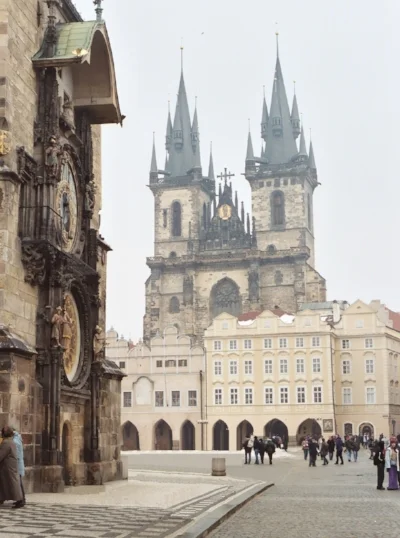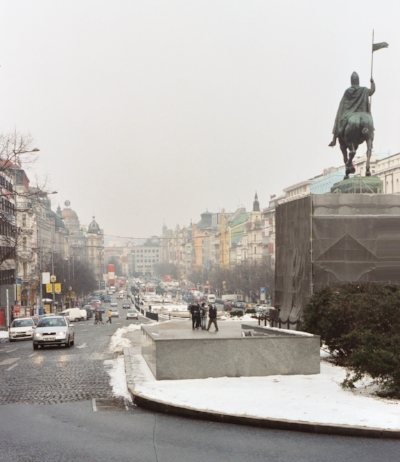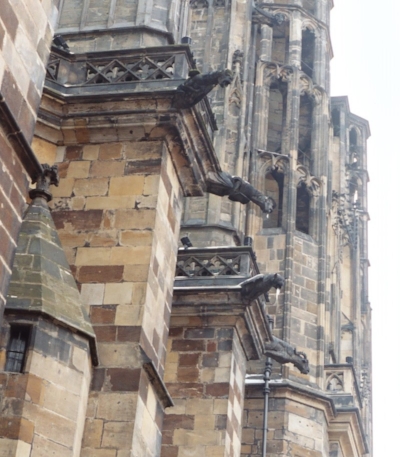The Church of Our Lady Before Tyn, founded in 1385, dominates Prague’s Old Town Square.
Over a decade ago, I squeezed in a 2-day visit to Prague in the Czech Republic and I remember feeling an evolved constancy of the city…it was modern, but it was a palimpsest of centuries layer-on-layer. Despite being bombed at the end of World War II, Prague is one of Europe’s largest cities to have endured and commingled so many centuries. Prague’s Old Towne Square intertwines cathedrals and buildings from the 1300s and 1400s, shops from the 1600s, the Apostle statues were added to the Astronomical Clock in the 1800s, and the striking Jan Hus statue from 1915 dominates the center. It all blends to offer itself as an ancient yet modern city.
Wenceslas Square, Prague, looking northwest.
A mile away in the New Town section of Prague is Wenceslas Square. The area was originally laid out in the middle of the Fourteenth Century as a horse market, but it has evolved to become the modern city’s financial, business, and political center; Wenceslas Square was the central location for the Velvet Revolution in 1989, freeing then Czechoslovakia from Communist rule and Soviet control.
Prague for me on those two frozen February days was a warren of unlabeled streets, cold expanses of squares and the open Vltava River bank, but every building—new or antique—was warm and welcoming. The people met me with their halting English, though I could not even attempt Czech; there are no cognates between the languages, so I was careful of my words and they were patient with me. It is the only European city where I met a shopkeeper who knew no English; she was young and knew no German nor French, either; I left the shop disappointed.
That same strangeness of language was present on the streets, where old trades and specialty shops (the marionette museum, for instance) thrive among modern fashion stores, hotels, and fast-food vendors. The streets are neither the gridwork of Colonial design, nor the circles of Roman design; they wander and end abruptly. I’ve written before about getting lost in the city at night, only to find other tourists equally lost.
The Astronomical Clock with the Apostles parading past the upper windows.
Embracing the city’s strangeness and my occasional “lostness” led me to wonderful discoveries all around Prague. I had set off from my hotel on a frigid morning—with snowflakes on the air and temperatures struggling in negative Celsius—seeking Prague Castle and St. Vitus Cathedral on the hill above the city. I wandered into Old Towne Square, where I joined a crowd to watch the hourly procession of Apostles around the Astronomical Clock. Most haunting and surprising was the discreet bell-ringing skeleton…tempus fugit.
The Old Jewish Cemetery.
I adjusted my course—mistakenly—and happened upon the Old Jewish Cemetery. Visually, it is stunning with its 12,000 headstones standing edge-to-edge, tumbling onto each other. It is astonishing historically and culturally, as well: because it was the only burial place for Prague Jews from 1439 to 1787, it’s estimated that 100,000 souls are interred there, sometimes in graves 12-layers deep. For me on that cold morning, the dusting of snow added to the eerie sanctity and the beauty.
The Charles Bridge over the Vltava River, the Prague Castle and St. Vitus Cathedral above.
When I reached the Charles Bridge to cross the Vltava River, I realized the bridge with its 30 statues is a destination in itself. I found myself lingering at many of the statues, reading explanatory plaques or eavesdropping on others’ conversations; I snapped several photographs for strangers—in 2005, people still used actual cameras; I paused at the statue of St. John of Nepomuk—who, legend says, was thrown from the bridge in 1383 by King Wenceslas IV. Like all the other tourists, I touched the base of the statue (where it was rubbed to a golden shine from constant contact) to invoke the superstition that I’d return someday to Prague.
Some of the St. Vitus Cathedral gargoyles.
I continued and made the long climb uphill to the Prague Castle and the St. Vitus Cathedral. Like so much of Prague, it layered modernity (security lines and heavily armed guards) over its antique Gothic beauty (construction began in 1344 and continued for almost six centuries). The Castle guards bundled against the weather and topped with large, furry hats reminded me of the witch’s guards in The Wizard of Oz and the Cathedral’s countless gargoyles recalled the movie’s flying monkeys.
I have a strong memory of sitting that night in the hotel restaurant for dinner, enjoying a cocktail, and watching as the snow continued falling. The fireplace crackled behind me, the street was lit but empty through the window. The server brought a basket of bread to the table and I remember thinking that it could have been almost any year and I could have had this very same experience of Prague.





